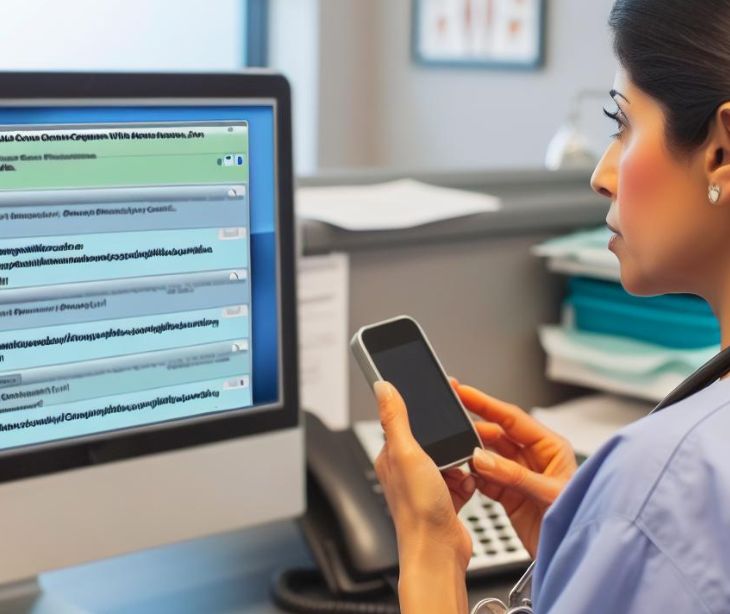3 min read
Using emails and texts for follow-ups during post-discharge care
Caitlin Anthoney April 02, 2024

Effective follow-up care can impact patient recovery and overall well-being. Providers can use HIPAA compliant emails and texts to communicate with patients, provide important information, and address any concerns or questions they may have after discharge.
Research shows that some “patients may prefer to use technology to traditional methods for communicating with the healthcare team post-hospital discharge.” Emails and secure messaging platforms have been found to be effective in improving communication between patients and healthcare providers, leading to improved patient outcomes and increased patient satisfaction.
Additionally, these digital communication methods can also help reduce the risk of miscommunication or misunderstandings that may occur with traditional methods such as phone calls or in-person visits.
Timely communication and follow-ups
Emails allow healthcare providers to send medication reminders, dietary instructions, and reminders for follow-up appointments. Similarly, text messaging platforms offer a convenient way to reach patients, especially those who prefer mobile communication.
This helps providers deliver timely updates and support, enhancing patient engagement and reducing readmission rates. A cohort study on hospital discharges among Medicaid patients supports this. This study showed that “patients attending a primary care follow-up appointment…had fewer 30—and 90-day readmissions compared with patients with less timely primary care follow-up or none.”
So, by using emails and texts for timely follow-ups, healthcare providers can effectively support patients in their recovery journey beyond the hospital walls, potentially reducing readmissions which could lead to improved health outcomes.
Improved patient engagement and education
HIPAA compliant emails and texts can send educational resources, relevant information and personalized support to patients. For example, if a patient is discharged after cardiac surgery, providers can send them automated emails. It can include information on managing medications, monitoring symptoms, and adopting heart-healthy lifestyle habits.
Additionally, providers can send timely text messages reminding them to attend cardiac rehabilitation sessions and providing encouragement to adhere to their prescribed treatment plan. Keeping the patient informed could help them gain a deeper understanding of their condition and the steps they need to take to promote their recovery.
Through these email and text communications, the patient gains a deeper understanding of their condition and the steps they need to take to promote their recovery.
Read also: How automated HIPAA compliant emails can increase patient satisfaction
Continued care and collaboration
BMC Health Services Research shows that remote patient monitoring via email “can improve patient follow-up and have a positive impact on quality of care (by limiting adverse events) and costs (by reducing readmissions).” In this study, nurses used emails to follow up on patients’ symptoms and toxicity, treatment compliance and care packages.
More specifically, these follow-ups facilitate communication among various healthcare providers involved in a patient's care continuum. For instance, a primary care physician can receive updates from specialists or hospital discharge summaries via email, keeping them informed about any changes in the patient's condition or treatment plan.
Healthcare workers can share insights, coordinate follow-up appointments, and address any concerns or questions that may arise during the post-discharge period. This real-time information exchange increases collaboration among healthcare teams, leading to more coordinated and patient-centered care.
Read also: How patient-centered communication improves patient outcomes
Cost-effective and eco-friendly
In addition to improving patient outcomes, emails and text follow-ups offer cost-effective solutions for healthcare organizations. Compared to traditional methods such as phone calls or postal mail, sending emails incurs minimal costs, saving resources and overhead expenses.
Provider organizations save on printing, postage, and administrative costs associated with traditional communication channels, and also benefit from increased efficiency and streamlined workflows.
Furthermore, using digital communication aligns with sustainability efforts by reducing paper usage and minimizing environmental impact. So, by adopting HIPAA-compliant emails and texts for follow-ups, providers optimize resource utilization while contributing to a greener, more eco-friendly healthcare system.
Go deeper: A healthcare email marketing ROI calculator
FAQs
What security measures should healthcare organizations implement to safeguard patient information in email or text follow-ups?
Healthcare organizations should use encryption and secure platforms, like Paubox, to safeguard protected health information (PHI) from unauthorized access.
What steps should healthcare providers take to ensure that follow-ups comply with HIPAA regulations?
Healthcare providers should implement policies and procedures to ensure that email communications are HIPAA compliant, including obtaining patient consent and using secure email platforms.
How can providers ensure that email follow-ups are effective in promoting patient engagement?
Healthcare organizations can personalize email communications, provide relevant and actionable information, and encourage two-way communication to promote patient engagement and participation in their care.
Subscribe to Paubox Weekly
Every Friday we'll bring you the most important news from Paubox. Our aim is to make you smarter, faster.



